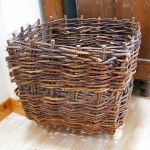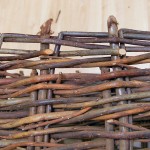Westside creels
(Shawbost, Barvas, Tolsta Chaolais)
Donald Macarthur of Shawbost taught me creel making and his creels are based on his father’s methods. See ‘How to make creels’
Malcolm Macarthur was the last professional creel maker on the island. Although traditionally all crofters made their own creels.
Makers used wooden frames (ceaps) drilled with the appropriate number of holes to stand the stakes in. Creels from this area use 6×6 templates, a total of 20 stakes. Each side is 17” long. These creels were started in two places with the twisted pairing weave.
Putting in the second stakes(viewed as the creel is being made, i.e. upside down)
These are put into the right of the first stakes. Then there are two methods of continuing. The first is that used by Donald Macarthur and is also used on one of the creels at Shawbost. Here once the second stakes have been kinked down, they are then used in a kind of French rand weave. The other creel at Shawbost after the first round of weave as above then goes into a thick twisted pairing weave.
Borders
These are not borders as basket makers generally weave, with the stakes. The creel is taken off the template after being fully woven. Then a ‘border’ is put on around the original butt ends. Donald’s border is to put another row of twisted pairing on the creel with the butt ends of two pairs of weavers crammed down beside the stakes and the ends then woven away under the weave.
Another Shawbost creel has a trac border added to it.
Uig/Great Bernera Creels
These creels, exemplified in those made by Donald MacDonald of Gisla(originally Bernera), are made on 7×7 templates, using 24 stakes. Each side is 18” long.
See Donald making a creel in the How to make section
Donald MacDonald said to me that the 24 creels were much better and stronger. Donald MacArthur who did 20 stake creels expressed how hard it was to get the side stakes woven into the bottom of the creel and wouldn’t want to have the extra one each side as on the 24 stake creels. And that extra stake is right in the middle of the bottom too…where there is the least room for weaving.
Uig creels are started with a form of mouth wale, although a simpler one than the ones on the Irish creels. Then the rods are woven in a form of French rand. After that the twisted pairing weave is used to the edge of the breugan (the ‘window’ section).
There is a cane creel in the Bernera Museum from Earsiader which is a village just next to Bernera. It has a very small gap which isn’t made by the above methods. The pairing is stopped and then started further up.
Putting in the second stakes
Donald MacDonald puts these in to the left hand side of the first stakes. He then kinks his down behind the first stake.
Ranish Creels
There is a Ranish creel in the Museum Nan Eilean collection. It is not known who the maker was. The construction is similar to the Uig creels. The only difference being that although the second stakes are put in to the left of the first stakes they are kinked down in front of that stake.
Ness creels
One of the creels in the Comunn Eachdraidh Nis collection is started using cane (see below). Unlike any other creel the piece of cane is looped round one of the stakes to start the pairing weave.
The other Ness creel we have there is made using wood strips for the stakes and then woven in cane, like a small line frame basket. Like creels woven in cane the side stakes of wood are cut off and cannot form part of the base.
Materials
All Lewis creels would originally have been made with locally grown willow, although there is the possibility of the use of heather as has been shown from Uist. Willow was planted on every croft and coppiced to give a yearly supply. When stripped willow was available to get sent up from Somerset, some makers switched to using that.
When cane became available from the port, it was readily taken up in creel making because of its superior resistance to rotting. Cane is sometimes used in the whole creel or more often in sections, such as at the start or in the base.
Dawn Susan









